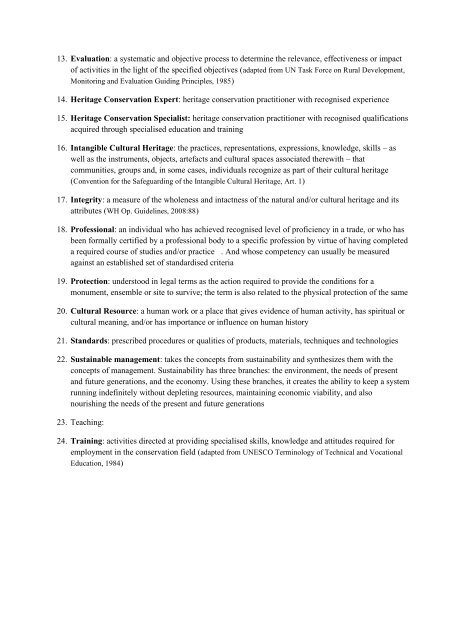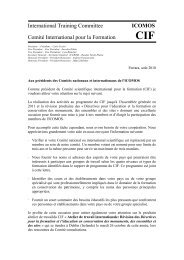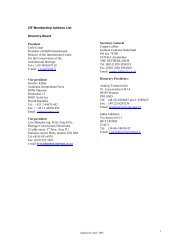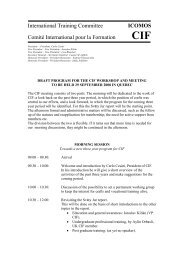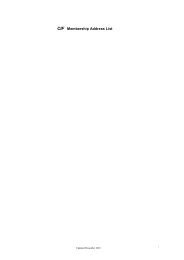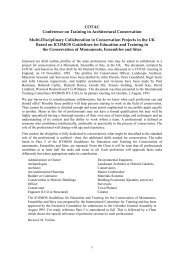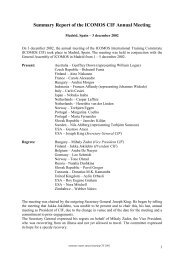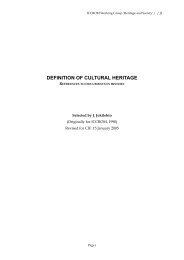Glossary of Terms_CIF Guidelines.pdf - Icomos
Glossary of Terms_CIF Guidelines.pdf - Icomos
Glossary of Terms_CIF Guidelines.pdf - Icomos
Create successful ePaper yourself
Turn your PDF publications into a flip-book with our unique Google optimized e-Paper software.
13. Evaluation: a systematic and objective process to determine the relevance, effectiveness or impact<br />
<strong>of</strong> activities in the light <strong>of</strong> the specified objectives (adapted from UN Task Force on Rural Development,<br />
Monitoring and Evaluation Guiding Principles, 1985)<br />
14. Heritage Conservation Expert: heritage conservation practitioner with recognised experience<br />
15. Heritage Conservation Specialist: heritage conservation practitioner with recognised qualifications<br />
acquired through specialised education and training<br />
16. Intangible Cultural Heritage: the practices, representations, expressions, knowledge, skills – as<br />
well as the instruments, objects, artefacts and cultural spaces associated therewith – that<br />
communities, groups and, in some cases, individuals recognize as part <strong>of</strong> their cultural heritage<br />
(Convention for the Safeguarding <strong>of</strong> the Intangible Cultural Heritage, Art. 1)<br />
17. Integrity: a measure <strong>of</strong> the wholeness and intactness <strong>of</strong> the natural and/or cultural heritage and its<br />
attributes (WH Op. <strong>Guidelines</strong>, 2008:88)<br />
18. Pr<strong>of</strong>essional: an individual who has achieved recognised level <strong>of</strong> pr<strong>of</strong>iciency in a trade, or who has<br />
been formally certified by a pr<strong>of</strong>essional body to a specific pr<strong>of</strong>ession by virtue <strong>of</strong> having completed<br />
a required course <strong>of</strong> studies and/or practice . And whose competency can usually be measured<br />
against an established set <strong>of</strong> standardised criteria<br />
19. Protection: understood in legal terms as the action required to provide the conditions for a<br />
monument, ensemble or site to survive; the term is also related to the physical protection <strong>of</strong> the same<br />
20. Cultural Resource: a human work or a place that gives evidence <strong>of</strong> human activity, has spiritual or<br />
cultural meaning, and/or has importance or influence on human history<br />
21. Standards: prescribed procedures or qualities <strong>of</strong> products, materials, techniques and technologies<br />
22. Sustainable management: takes the concepts from sustainability and synthesizes them with the<br />
concepts <strong>of</strong> management. Sustainability has three branches: the environment, the needs <strong>of</strong> present<br />
and future generations, and the economy. Using these branches, it creates the ability to keep a system<br />
running indefinitely without depleting resources, maintaining economic viability, and also<br />
nourishing the needs <strong>of</strong> the present and future generations<br />
23. Teaching:<br />
24. Training: activities directed at providing specialised skills, knowledge and attitudes required for<br />
employment in the conservation field (adapted from UNESCO Terminology <strong>of</strong> Technical and Vocational<br />
Education, 1984)


